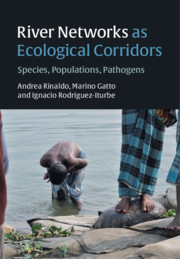4 - Waterborne Disease
Published online by Cambridge University Press: 01 October 2020
Summary
This chapter illustrates the implications of river network structure for the spread of waterborne diseases. Human mobility is also added as a driver and a network of interaction. The water-related (WR) diseases considered are epidemic cholera, endemic schistosomiasis, and proliferative kidney disease in fish. After reviewing the basic (space-implicit) epidemiological models for micro- and micro-parasites, general space-explicit models for both kinds of parasites are studied. Both the hydrologic and the human mobility network are included, and the general conditions for disease establishment are derived, including also the case of seasonal forcings. Conditions for transient (though possibly large) epidemics are also found. The microparasitic model is applied to several cholera epidemics, including the one that has been devastating Haiti. Spatially explicit macroparasitic models of schistosomiasis are then analyzed and applied to the cases of Senegal and Burkina Faso. Proliferative kidney disease (PKD) in salmonid fish, a pathology linked to global warming, is modeled. The space-explicit approach is used for the study of PKD spread in the basin of the river Wigger (Switzerland).
Keywords
- Type
- Chapter
- Information
- River Networks as Ecological CorridorsSpecies, Populations, Pathogens, pp. 225 - 339Publisher: Cambridge University PressPrint publication year: 2020

